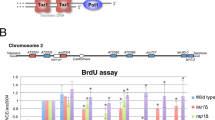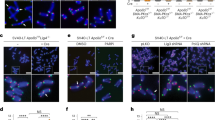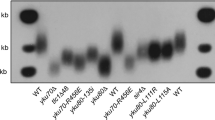Abstract
Telomerase in Saccharomyces cerevisiae binds and preferentially elongates short telomeres, and this process requires the checkpoint kinase Tel1. Here we show that the Mre11 complex bound preferentially to short telomeres, which could explain the preferential binding of Tel1 to these ends. Compared to wild-type length telomeres, short telomeres generated by incomplete replication had low levels of the telomerase inhibitory protein Rif2. Moreover, in the absence of Rif2, Tel1 bound equally well to short and wild-type length telomeres, suggesting that low Rif2 content marks short telomeres for preferential elongation. In congenic strains, a double-strand break bound at least 140 times as much Mec1 in the first cell cycle after breakage as did a short telomere in the same time frame. Binding of replication protein A was also much lower at short telomeres. The absence of Mec1 at short telomeres could explain why they do not trigger a checkpoint-mediated cell-cycle arrest.
This is a preview of subscription content, access via your institution
Access options
Subscribe to this journal
Receive 12 print issues and online access
$189.00 per year
only $15.75 per issue
Buy this article
- Purchase on Springer Link
- Instant access to full article PDF
Prices may be subject to local taxes which are calculated during checkout






Similar content being viewed by others
References
Gall, J.G. in Telomeres (eds. Blackburn, E.H. & Greider, C.W.) 1–10 (Cold Spring Harbor Laboratory Press, 1995).
Sabourin, M. & Zakian, V.A. ATM-like kinases and regulation of telomerase: lessons from yeast and mammals. Trends Cell Biol. 18, 337–346 (2008).
Vega, L.R., Mateyak, M. & Zakian, V. Getting to the end: telomerase access in yeast and humans. Nat. Rev. Mol. Cell Biol. 4, 948–959 (2003).
Marcand, S., Brevet, V. & Gilson, E. Progressive cis-inhibition of telomerase upon telomere elongation. EMBO J. 18, 3509–3519 (1999).
Teixeira, M.T., Arneric, M., Sperisen, P. & Lingner, J. Telomere length homeostasis is achieved via a switch between telomerase-extendible and -nonextendible states. Cell 117, 323–335 (2004).
Hemann, M.T., Strong, M.A., Hao, L.Y. & Greider, C.W. The shortest telomere, not average telomere length, is critical for cell viability and chromosome stability. Cell 107, 67–77 (2001).
Chang, M., Arneric, M. & Lingner, J. Telomerase repeat addition processivity is increased at critically short telomeres in a Tel1-dependent manner in Saccharomyces cerevisiae. Genes Dev. 21, 2485–2494 (2007).
Sabourin, M., Tuzon, C. & Zakian, V.A. Telomerase and Tel1p preferentially associate with short telomeres in S. cerevisiae. Mol. Cell 27, 550–561 (2007).
Bianchi, A. & Shore, D. Increased association of telomerase with short telomeres in yeast. Genes Dev. 21, 1726–1730 (2007).
Hector, R.E. et al. Tel1p preferentially associates with short telomeres to stimulate their elongation. Mol. Cell 27, 851–858 (2007).
Gilson, E., Roberge, M., Giraldo, R., Rhodes, D. & Gasser, S.M. Distortion of the DNA double helix by RAP1 at silencers and multiple telomeric binding sites. J. Mol. Biol. 231, 293–310 (1993).
Hirano, Y., Fukunaga, K. & Sugimoto, K. Rif1 and Rif2 inhibit localization of Tel1 to DNA ends. Mol. Cell 33, 312–322 (2009).
Ritchie, K.B., Mallory, J.C. & Petes, T.D. Interactions of TLC1 (which encodes the RNA subunit of telomerase), TEL1, and MEC1 in regulating telomere length in the yeast Saccharomyces cerevisiae. Mol. Cell. Biol. 19, 6065–6075 (1999).
Arnerić, M. & Lingner, J. Tel1 kinase and subtelomere-bound Tbf1 mediate preferential elongation of short telomeres by telomerase in yeast. EMBO Rep. 8, 1080–1085 (2007).
Nakada, D., Hirano, Y., Tanaka, Y. & Sugimoto, K. Role of the C terminus of Mec1 checkpoint kinase in its localization to sites of DNA damage. Mol. Biol. Cell 16, 5227–5235 (2005).
Nakada, D., Matsumoto, K. & Sugimoto, K. ATM-related Tel1 associates with double-strand breaks through an Xrs2-dependent mechanism. Genes Dev. 17, 1957–1962 (2003).
Craven, R.J., Greenwell, P.W., Dominska, M. & Petes, T.D. Regulation of genome stability by TEL1 and MEC1, yeast homologs of the mammalian ATM and ATR genes. Genetics 161, 493–507 (2002).
Mallory, J.C. & Petes, T.D. Protein kinase activity of tel1p and mec1p, two Saccharomyces cerevisiae proteins related to the human ATM protein kinase. Proc. Natl. Acad. Sci. USA 97, 13749–13754 (2000).
Voziyanov, Y., Lee, J., Whang, I. & Jayaram, M. Analyses of the first chemical step in Flp site-specific recombination: Synapsis may not be a pre-requisite for strand cleavage. J. Mol. Biol. 256, 720–735 (1996).
Dubrana, K., van Attikum, H., Hediger, F. & Gasser, S.M. The processing of double-strand breaks and binding of single-strand-binding proteins RPA and Rad51 modulate the formation of ATR-kinase foci in yeast. J. Cell Sci. 120, 4209–4220 (2007).
Hirano, Y. & Sugimoto, K. Cdc13 telomere capping decreases Mec1 association but does not affect Tel1 association with DNA ends. Mol. Biol. Cell 18, 2026–2036 (2007).
Kondo, T., Wakayama, T., Naiki, T., Matsumoto, K. & Sugimoto, K. Recruitment of Mec1 and Ddc1 checkpoint proteins to double-strand breaks through distinct mechanisms. Science 294, 867–870 (2001).
Rouse, J. & Jackson, S.P. Lcd1p recruits Mec1p to DNA lesions in vitro and in vivo. Mol. Cell 9, 857–869 (2002).
Bianchi, A., Negrini, S. & Shore, D. Delivery of yeast telomerase to a DNA break depends on the recruitment functions of Cdc13 and Est1. Mol. Cell 16, 139–146 (2004).
Negrini, S., Ribaud, V., Bianchi, A. & Shore, D. DNA breaks are masked by multiple Rap1 binding in yeast: implications for telomere capping and telomerase regulation. Genes Dev. 21, 292–302 (2007).
Oza, P., Jaspersen, S.L., Miele, A., Dekker, J. & Peterson, C.L. Mechanisms that regulate localization of a DNA double-strand break to the nuclear periphery. Genes Dev. 23, 912–927 (2009).
Harrison, J.C. & Haber, J.E. Surviving the breakup: the DNA damage checkpoint. Annu. Rev. Genet. 40, 209–235 (2006).
Iftode, C., Daniely, Y. & Borowiec, J.A. Replication protein A (RPA): the eukaryotic SSB. Crit. Rev. Biochem. Mol. Biol. 34, 141–180 (1999).
Lisby, M., Barlow, J.H., Burgess, R.C. & Rothstein, R. Choreography of the DNA damage response: spatiotemporal relationships among checkpoint and repair proteins. Cell 118, 699–713 (2004).
Ira, G. et al. DNA end resection, homologous recombination and DNA damage checkpoint activation require CDK1. Nature 431, 1011–1017 (2004).
Wang, X. & Haber, J.E. Role of Saccharomyces single-stranded DNA-binding protein RPA in the strand invasion step of double-strand break repair. PLoS Biol. 2, E21 (2004).
Schramke, V. et al. RPA regulates telomerase action by providing Est1p access to chromosome ends. Nat. Genet. 36, 46–54 (2004).
Foster, E.R. & Downs, J.A. Histone H2A phosphorylation in DNA double-strand break repair. FEBS J. 272, 3231–3240 (2005).
Downs, J.A., Lowndes, N.F. & Jackson, S.P. A role for Saccharomyces cerevisiae histone H2A in DNA repair. Nature 408, 1001–1004 (2000).
Kim, J.A., Kruhlak, M., Dotiwala, F., Nussenzweig, A. & Haber, J.E. Heterochromatin is refractory to gamma-H2AX modification in yeast and mammals. J. Cell Biol. 178, 209–218 (2007).
Szilard, R.K. et al. Systematic identification of fragile sites via genome-wide location analysis of γ-H2AX. Nat. Struct. Mol. Biol. 17, 299–305 (2010).
Shampay, J. & Blackburn, E.H. Generation of telomere-length heterogeneity in Saccharomyces cerevisiae. Proc. Natl. Acad. Sci. USA 85, 534–538 (1988).
Takata, H., Kanoh, Y., Gunge, N., Shirahige, K. & Matsuura, A. Reciprocal association of the budding yeast ATM-related proteins Tel1 and Mec1 with telomeres in vivo. Mol. Cell 14, 515–522 (2004).
Takata, H., Tanaka, Y. & Matsuura, A. Late S phase-specific recruitment of Mre11 complex triggers hierarchical assembly of telomere replication proteins in Saccharomyces cerevisiae. Mol. Cell 17, 573–583 (2005).
Smolka, M.B., Albuquerque, C.P., Chen, S.H. & Zhou, H. Proteome-wide identification of in vivo targets of DNA damage checkpoint kinases. Proc. Natl. Acad. Sci. USA 104, 10364–10369 (2007).
Levy, D.L. & Blackburn, E.H. Counting of Rif1p and Rif2p on Saccharomyces cerevisiae telomeres regulates telomere length. Mol. Cell. Biol. 24, 10857–10867 (2004).
Bonetti, D., Martina, M., Clerici, M., Lucchini, G. & Longhese, M.P. Multiple pathways regulate 3′ overhang generation at S. cerevisiae telomeres. Mol. Cell 35, 70–81 (2009).
Mimitou, E.P. & Symington, L.S. Sae2, Exo1 and Sgs1 collaborate in DNA double-strand break processing. Nature 455, 770–774 (2008).
Zhu, Z., Chung, W.H., Shim, E.Y., Lee, S.E. & Ira, G. Sgs1 helicase and two nucleases Dna2 and Exo1 resect DNA double-strand break ends. Cell 134, 981–994 (2008).
Taggart, A.K.P., Teng, S.-C. & Zakian, V.A. Est1p as a cell cycle-regulated activator of telomere-bound telomerase. Science 297, 1023–1026 (2002).
Cortez, D., Guntuku, S., Qin, J. & Elledge, S.J. ATR and ATRIP: partners in checkpoint signaling. Science 294, 1713–1716 (2001).
Zou, L. & Elledge, S.J. Sensing DNA damage through ATRIP recognition of RPA-ssDNA complexes. Science 300, 1542–1548 (2003).
Michelson, R.J., Rosenstein, S. & Weinert, T. A telomeric repeat sequence adjacent to a DNA double-stranded break produces an anticheckpoint. Genes Dev. 19, 2546–2559 (2005).
Verdun, R.E. & Karlseder, J. The DNA damage machinery and homologous recombination pathway act consecutively to protect human telomeres. Cell 127, 709–720 (2006).
Verdun, R.E., Crabbe, L., Haggblom, C. & Karlseder, J. Functional human telomeres are recognized as DNA damage in G2 of the cell cycle. Mol. Cell 20, 551–561 (2005).
Viscardi, V., Bonetti, D., Cartagena-Lirola, H., Lucchini, G. & Longhese, M.P. MRX-dependent DNA damage response to short telomeres. Mol. Biol. Cell 18, 3047–3058 (2007).
Sandell, L.L. & Zakian, V.A. Loss of a yeast telomere: arrest, recovery and chromosome loss. Cell 75, 729–739 (1993).
Zhao, X., Muller, E.G. & Rothstein, R. A suppressor of two essential checkpoint genes identifies a novel protein that negatively affects dNTP pools. Mol. Cell 2, 329–340 (1998).
Lorenz, M.C. et al. Gene disruption with PCR products in Saccharomyces cerevisiae. Gene 158, 113–117 (1995).
Goudsouzian, L.K., Tuzon, C. & Zakian, V.A. S. cerevisiae Tel1p and Mre11p are required for normal levels of Est1p and Est2p telomere association. Mol. Cell 24, 603–610 (2006).
Fisher, T.S., Taggart, A. & Zakian, V. Cell cycle-dependent regulation of yeast telomerase by Ku. Nat. Struct. Mol. Biol. 11, 1198–1205 (2004).
Conrad, M.N., Wright, J.H., Wolf, A.J. & Zakian, V.A. RAP1 protein interacts with yeast telomeres in vivo: overproduction alters telomere structure and decreases chromosome stability. Cell 63, 739–750 (1990).
Acknowledgements
We thank D. Shore and A. Bianchi (University of Geneva) for strains and advice on the DSB assay, K. Runge for advice on telomere PCR, T. Petes (Duke University) for strains, M. Jayaram for discussions about FLP-induced DSBs and C. Webb and Y. Wu for comments on the manuscript. This work was supported by grants from the US National Institutes of Health (NIH; GM43265 to V.A.Z.), postdoctoral fellowships from the NIH (M.S.), Deutsche Forschungsgemeinschaft (K.P.) and NJCCR (K.P.), and predoctoral fellowships from NJCCR (J.A.P., J.S.M.) and NIH (J.S.M.).
Author information
Authors and Affiliations
Contributions
J.S.M. did the experiments in Figures 5 and 6, J.A.P. did the experiments in Figure 3, A.C. and M.S. did experiments in Figures 1, 2 and 4, and K.P. helped with analysis of H2A phosphorylation. V.A.Z. and all other authors participated in the design and interpretation of experiments and in the preparation of the manuscript.
Corresponding author
Ethics declarations
Competing interests
The authors declare no competing financial interests.
Supplementary information
Supplementary Text and Figures
Supplementary Figures 1–4, Supplementary Tables 1 and 2 and Supplementary Methods (PDF 1726 kb)
Rights and permissions
About this article
Cite this article
McGee, J., Phillips, J., Chan, A. et al. Reduced Rif2 and lack of Mec1 target short telomeres for elongation rather than double-strand break repair. Nat Struct Mol Biol 17, 1438–1445 (2010). https://doi.org/10.1038/nsmb.1947
Received:
Accepted:
Published:
Issue Date:
DOI: https://doi.org/10.1038/nsmb.1947
This article is cited by
-
Inhibition of MRN activity by a telomere protein motif
Nature Communications (2021)
-
Mechanism of MRX inhibition by Rif2 at telomeres
Nature Communications (2021)
-
Fine tuning the level of the Cdc13 telomere-capping protein for maximal chromosome stability performance
Current Genetics (2019)
-
Mec1ATR is needed for extensive telomere elongation in response to ethanol in yeast
Current Genetics (2018)
-
Telomere-end processing: mechanisms and regulation
Chromosoma (2014)



